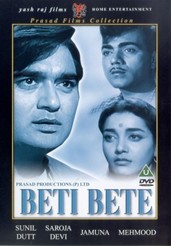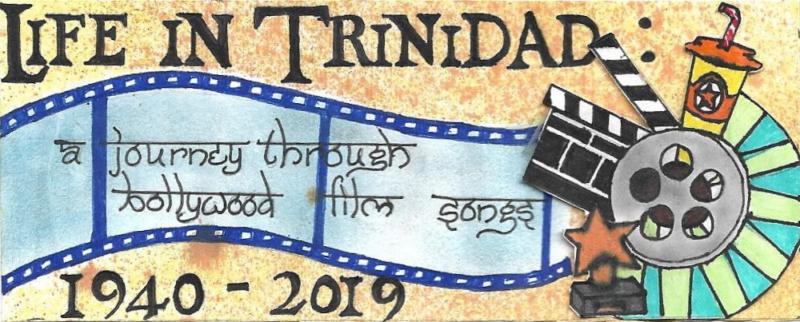Aaj Kal Mein Dhal Gaya
| Song Title | Aaj Kal Mein Dhal Gaya |
| Movie Title | Beti Bete |
| Date Released (India) | June 1, 1964 |
| Date Released (Trinidad) | Unknown |
| Singer | Mohammed Rafi and Lata Mangeshkar |
| Lyricist | Shailendra |
| Composer | Shankar Jaikishan |
| Starring | Sunil Dutt, B. Saroja Devi, Jamuna, and Mehmood |
Music video of Aaj Kal Mein Dhal Gaya from the movie Beti Bete.
Song Lyrics
| Mohammed Rafi | Mohammed Rafi |
| aaj kal mein dhal gaya din hua tamam tu bhi soja so gayi rang bhari shaam | “Today” has transformed into “tomorrow”, the day is over. You, too, go to bed. The vibrant evening has gone to sleep. |
| Lata Mangeshkar | Lata Mangeshkar |
| aaj kal mein dhal gaya din hua tamam tu bhi soja so gayi rang bhari shaam aaj kal mein dhal gaya | “Today” has transformed into “tomorrow”, the day is over. You, too, go to bed. The vibrant evening has gone to sleep. “Today” has transformed into “tomorrow” |
| Mohammed Rafi | Mohammed Rafi |
| so gaya chaman chaman, so gayi kali kali so gaye hai sab nagar, so gayi gali gali so gaya chaman chaman, so gayi kali kali so gaye hai sab nagar, so gayi gali gali nind keh rahi hai chal, meri bahe tham tu bhi soja so gayi rang bhari shaam aaj kal mein dhal gaya | Every flower-garden went to sleep, every flower-bud is asleep The entire town has gone to sleep, every street is asleep Every flower-garden went to sleep, every flower-bud is asleep The entire town has gone to sleep, every street is asleep Sleep is saying, “Come, hold on to my arms” You, too, go to bed. The vibrant evening has gone to sleep. “Today” has transformed into “tomorrow” |
| Lata Mangeshkar | Lata Mangeshkar |
| hai bujha bujha sa dil, bojh sans sans par ji rahe hai phir bhi ham, sirf kal ki aas par hai bujha bujha sa dil, bojh sans sans par ji rahe hai phir bhi ham, sirf kal ki aas par keh rahi hai chandani, leke tera naam tu bhi soja so gayi rang bhari shaam aaj kal mein dhal gaya | Our hearts are depressed, every breath is a burden Yet we live, hoping for a better tomorrow Our hearts are depressed, every breath is a burden Yet we live, hoping for a better tomorrow The moonlight calls out your name and says, You, too, go to bed. The vibrant evening has gone to sleep. “Today” has transformed into “tomorrow” |
| Mohammed Rafi | Mohammed Rafi |
| kaun aaye ga idhar, kiski rah dekhe ham jinki ahate suni, jaane kiske the kadam kaun aaye ga idhar, kiski rah dekhe ham jinki ahate suni, jaane kiske the kadam apna koi bhi nahi, apne hai to ram | No one will come here, whom should we wait for? The footsteps we heard, who knows whose footsteps they were? No one will come here, whom should we wait for? The footsteps we heard, who knows whose footsteps they were? We have no one in the world, only God. |
| Lata Mangeshkar | Lata Mangeshkar |
| tu bhi soja so gayi rang bhari shaam aaj kal mein dhal gaya din hua tamam | You, too, go to bed. The vibrant evening has gone to sleep. “Today” has transformed into “tomorrow”, the day is over. |
Mohammed Rafi |
aaj kal mein dhal gaya din hua tamam tu bhi soja so gayi rang bhari shaam |
Lata Mangeshkar |
aaj kal mein dhal gaya din hua tamam tu bhi soja so gayi rang bhari shaam aaj kal mein dhal gaya |
Mohammed Rafi |
so gaya chaman chaman, so gayi kali kali so gaye hai sab nagar, so gayi gali gali so gaya chaman chaman, so gayi kali kali so gaye hai sab nagar, so gayi gali gali nind keh rahi hai chal, meri bahe tham tu bhi soja so gayi rang bhari shaam aaj kal mein dhal gaya |
Lata Mangeshkar |
hai bujha bujha sa dil, bojh sans sans par ji rahe hai phir bhi ham, sirf kal ki aas par hai bujha bujha sa dil, bojh sans sans par ji rahe hai phir bhi ham, sirf kal ki aas par keh rahi hai chandani, leke tera naam tu bhi soja so gayi rang bhari shaam aaj kal mein dhal gaya |
Mohammed Rafi |
kaun aaye ga idhar, kiski rah dekhe ham jinki ahate suni, jaane kiske the kadam kaun aaye ga idhar, kiski rah dekhe ham jinki ahate suni, jaane kiske the kadam apna koi bhi nahi, apne hai to ram |
Lata Mangeshkar |
tu bhi soja so gayi rang bhari shaam aaj kal mein dhal gaya din hua tamam |
| Mohammed Rafi |
| aaj kal mein dhal gaya din hua tamam tu bhi soja so gayi rang bhari shaam |
| Lata Mangeshkar |
| aaj kal mein dhal gaya din hua tamam tu bhi soja so gayi rang bhari shaam aaj kal mein dhal gaya |
| Mohammed Rafi |
| so gaya chaman chaman, so gayi kali kali so gaye hai sab nagar, so gayi gali gali so gaya chaman chaman, so gayi kali kali so gaye hai sab nagar, so gayi gali gali nind keh rahi hai chal, meri bahe tham tu bhi soja so gayi rang bhari shaam aaj kal mein dhal gaya |
| Lata Mangeshkar |
| hai bujha bujha sa dil, bojh sans sans par ji rahe hai phir bhi ham, sirf kal ki aas par hai bujha bujha sa dil, bojh sans sans par ji rahe hai phir bhi ham, sirf kal ki aas par keh rahi hai chandani, leke tera naam tu bhi soja so gayi rang bhari shaam aaj kal mein dhal gaya |
| Mohammed Rafi |
| kaun aaye ga idhar, kiski rah dekhe ham jinki ahate suni, jaane kiske the kadam kaun aaye ga idhar, kiski rah dekhe ham jinki ahate suni, jaane kiske the kadam apna koi bhi nahi, apne hai to ram |
| Lata Mangeshkar |
| tu bhi soja so gayi rang bhari shaam aaj kal mein dhal gaya din hua tamam |
| Mohammed Rafi |
| “Today” has transformed into “tomorrow”, the day is over. You, too, go to bed. The vibrant evening has gone to sleep. |
| Lata Mangeshkar |
| “Today” has transformed into “tomorrow”, the day is over. You, too, go to bed. The vibrant evening has gone to sleep. “Today” has transformed into “tomorrow” |
| Mohammed Rafi |
| Every flower-garden went to sleep, every flower-bud is asleep The entire town has gone to sleep, every street is asleep Every flower-garden went to sleep, every flower-bud is asleep The entire town has gone to sleep, every street is asleep Sleep is saying, “Come, hold on to my arms” You, too, go to bed. The vibrant evening has gone to sleep. “Today” has transformed into “tomorrow” |
| Lata Mangeshkar |
| Our hearts are depressed, every breath is a burden Yet we live, hoping for a better tomorrow Our hearts are depressed, every breath is a burden Yet we live, hoping for a better tomorrow The moonlight calls out your name and says, You, too, go to bed. The vibrant evening has gone to sleep. “Today” has transformed into “tomorrow” |
| Mohammed Rafi |
| No one will come here, whom should we wait for? The footsteps we heard, who knows whose footsteps they were? No one will come here, whom should we wait for? The footsteps we heard, who knows whose footsteps they were? We have no one in the world, only God. |
| Lata Mangeshkar |
| You, too, go to bed. The vibrant evening has gone to sleep. “Today” has transformed into “tomorrow”, the day is over. |
About The Lyrics
The Hindi lyrics of this song were mostly obtained from the Hindi Geetmala website [1]. The English translation of the song was obtained from the English subtitles of the original movie. Some parts were taken from a blog by Aruna3 [2]. The final version of the translation was put together by P. Mohan [3].
Fun Facts
The central phrase “aaj kal mein dhal gaya” (आज कल में ढल गया) “today has transformed into tomorrow” uses “dhal” (to pour/transform), creating a poetic metaphor where time literally “pours” from today into tomorrow – a usage that predates modern Hindi by centuries. The lyrics “rang bhari shaam” (रंग भरी शाम) or “vibrant evening” employs “rang” which is derived from Sanskrit’s “ranga” meaning both color and emotion, suggesting the evening is both visually and emotionally rich, while “shaam” traces to Sanskrit “shyama” (dark/evening), creating a beautiful oxymoron of colorful darkness. The repetition of “so gaya/gayi” (सो गया/गयी) or “went to sleep” uses different gender endings to personify everything from “chaman” (चमन) or “gardens” (masculine) to “kali” (कली) or “buds” (feminine), showing Urdu poetry’s tendency to give gender and life to inanimate objects. The famous temporal ambiguity of “kal” (कल) meaning both “yesterday” and “tomorrow” is derived from the Sanskrit word “kalah” meaning time itself, suggests time’s cyclical nature rather than linear progression in the song.
The song embodies the Indian philosophical concept of “kshanikata” or (transience) – everything from gardens to cities to time itself is temporary and cyclical. The line “sirf kal ki aas par” (सिर्फ़ कल की आस पर) which translates to “living only on tomorrow’s hope” in English, reflects the Vedantic idea that humans exist in a constant state of becoming rather than being, while “hai bujha bujha sa dil” (है बुझा बुझा सा दिल) or “our hearts are depressed” captures existential melancholy that echoes Buddhist concepts of dukkha (suffering) inherent in existence. The contrast between communal sleep – “so gaye hai sab nagar” (सो गये हैं सब नगर) or “the entire town has gone to sleep” – and individual awakeness suggests the existential loneliness that transcends even universal rest.
This style of duet, where Mohammed Rafi and Lata Mangeshkar alternate verses while sharing refrains, was popularized in 1950s Hindi cinema as a way to represent internal dialogue or shared emotional states between characters, reflecting the era’s sophisticated approach to conveying complex emotions. The imagery of “kiski rah dekhe ham” (किसकी राह देखें हम) or “whom should we wait for” and “jaane kiske the kadam” (जाने किसके थे कदम) or “who knows whose footsteps they were” may reflect post-Partition anxieties about displacement and waiting for loved ones who might never return, while empty streets and unknown footsteps evoke the broader uncertainty of the time. The final surrender in “apne hai to ram” (अपने हैं तो राम) or “we have only God” instead of human companionship reflects a cultural shift toward spiritual solace during uncertain times, with “Ram” representing not just devotional faith but the universal consciousness that remains when all personal attachments fade.
References
[2] https://roseyevening.wordpress.com/2017/09/23/english-translation-aajkal-me-dhal-gaya/
[3] Mohan, Permanand. Life in Trinidad: A Journey Through Bollywood Film Songs and Trini Calypso. https://lifeintrinidad.org/

